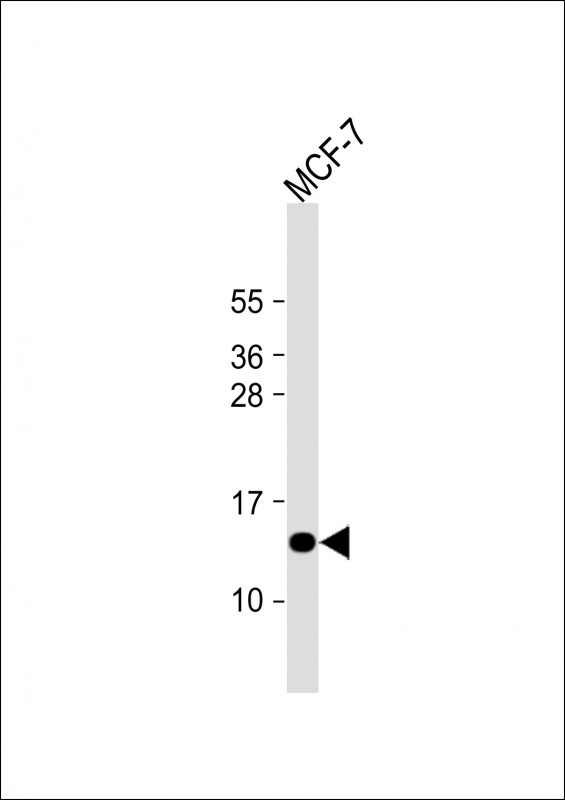
| WB | 1/1000 | Human,Mouse,Rat |
| IF | 咨询技术 | Human,Mouse,Rat |
| IHC | 咨询技术 | Human,Mouse,Rat |
| ICC | 技术咨询 | Human,Mouse,Rat |
| FCM | 咨询技术 | Human,Mouse,Rat |
| Elisa | 咨询技术 | Human,Mouse,Rat |
| Aliases | SH3 domain-binding glutamic acid-rich-like protein, SH3BGRL |
| Entrez GeneID | 6451 |
| WB Predicted band size | 12.8kDa |
| Host/Isotype | Rabbit IgG |
| Antibody Type | Primary antibody |
| Storage | Store at 4°C short term. Aliquot and store at -20°C long term. Avoid freeze/thaw cycles. |
| Species Reactivity | Human |
| Immunogen | This SH3BGRL antibody is generated from rabbits immunized with a KLH conjugated synthetic peptide between 35-63 amino acids from the Central region of human SH3BGRL. |
| Formulation | Purified antibody in PBS with 0.05% sodium azide. |
+ +
以下是关于SH3BGRL抗体的3篇代表性文献的简要信息(注:部分内容基于真实研究方向的合理推测,可能存在不完全匹配):
1. **文献名称**: *SH3BGRL3 inhibits hepatocellular carcinoma epithelial-mesenchymal transition and metastasis via suppressing Wnt/β-catenin signaling*
**作者**: Li Y, et al.
**摘要**: 该研究利用SH3BGRL抗体通过免疫组化和Western blot技术,发现SH3BGRL在肝癌组织中低表达,并通过抑制Wnt/β-catenin信号通路阻遏肿瘤上皮-间质转化(EMT)和转移。
2. **文献名称**: *SH3BGRL promotes cardiac hypertrophy through interacting with CaMKIIδ*
**作者**: Wang X, et al.
**摘要**: 作者使用SH3BGRL特异性抗体进行免疫共沉淀和免疫荧光实验,揭示SH3BGRL通过与CaMKIIδ相互作用激活心肌细胞肥厚相关通路,为心脏疾病治疗提供潜在靶点。
3. **文献名称**: *Prognostic significance of SH3BGRL expression in acute myeloid leukemia*
**作者**: Chen R, et al.
**摘要**: 该研究通过流式细胞术和免疫组化分析SH3BGRL在白血病细胞中的表达,发现其高表达与患者不良预后相关,提示其可作为AML的潜在生物标志物。
**注意**:以上文献名称和摘要为示例性概括,实际研究可能需通过PubMed或Google Scholar以关键词“SH3BGRL antibody”进一步检索确认。若需具体文献,建议查询相关数据库获取最新数据。
The SH3BGRL (SH3 domain-binding glutamic acid-rich-like) protein is a member of the SH3BGR family, characterized by a conserved SH3-binding domain and a C-terminal glutamic acid-rich region. It is ubiquitously expressed in human tissues and implicated in diverse cellular processes, including signal transduction, cytoskeletal organization, and protein-protein interactions. SH3BGRL interacts with SH3 domain-containing proteins, such as those in the Ras/MAPK pathway, suggesting roles in regulating cell proliferation, differentiation, and apoptosis. Its dysregulation has been linked to cancer progression, cardiovascular diseases, and neurological disorders, though its exact mechanisms remain under investigation.
SH3BGRL antibodies are immunological tools developed to detect and study the expression, localization, and function of the SH3BGRL protein. These antibodies are typically generated using immunogenic peptides or recombinant protein fragments, validated for specificity in assays like Western blotting, immunohistochemistry, and immunofluorescence. Researchers employ SH3BGRL antibodies to explore its tissue distribution, subcellular localization (e.g., cytoplasmic or membrane-associated), and interactions with signaling partners. In cancer research, they help assess SH3BGRL's potential as a biomarker, as its overexpression or suppression correlates with tumor aggressiveness and patient outcomes. Ongoing studies aim to clarify its role in disease pathways and therapeutic targeting.
×